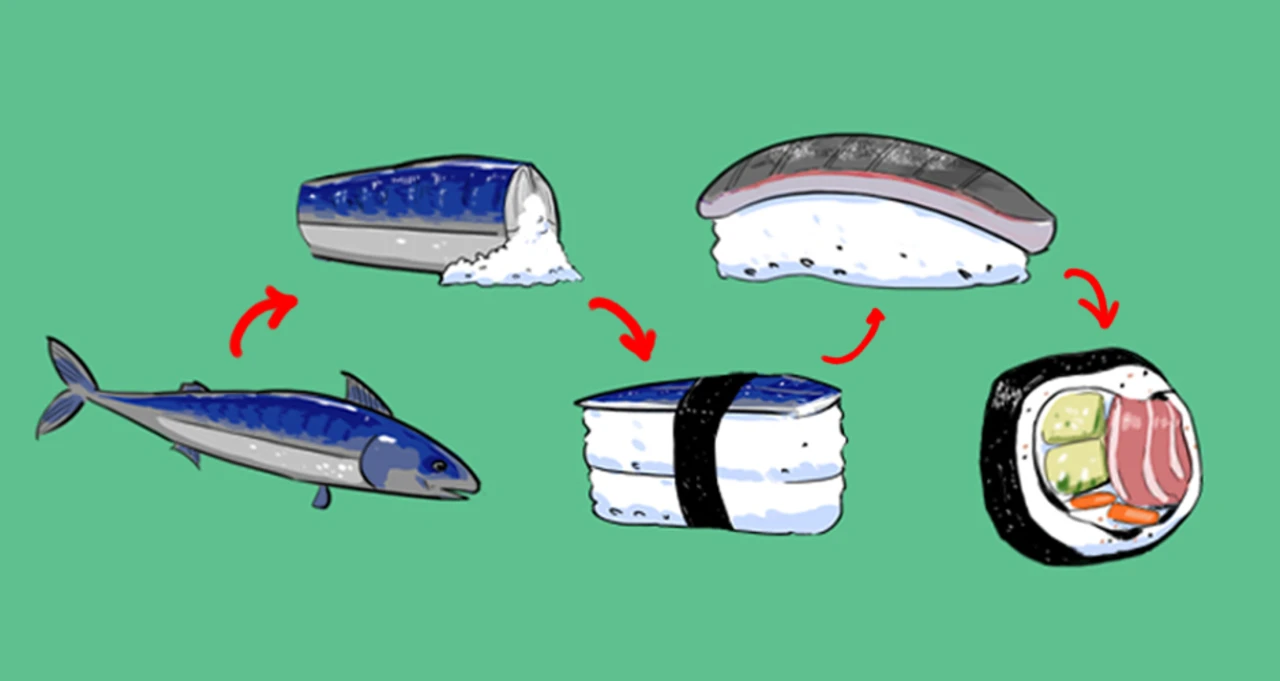A Synopsis of Sushi’s History
The dish from Japan with humble beginnings that took over the world.
Fresh and tasty
But it was worthwhile to pay more than necessary. By any definition, it was a stunning fish that was “so excellent and fresh,” as a beaming Mr. Kimura exclaimed to the world’s media. It was also unusual. The Pacific bluefin tuna is categorised as a vulnerable species, and over the past six years, attempts have been undertaken to reduce the magnitude of captures, even though it is not as critically endangered as its relatives in the south. Most importantly, it was excellent publicity. Kimura was demonstrating to the world that only the greatest fish is used to make sushi at his restaurants by paying such an outrageous fee for a single tuna. This basic variety of sushi, known as nare-sushi, started to catch on gradually. From the Mekong, it moved north along the Yangtze and into the present Chinese provinces of Yunnan, Guanxi, and Guizhou before moving south into Malaysia, Indonesia, and the Philippines. Invasion advanced it. Nare-sushi was then introduced into the Chinese heartland through a process of cultural assimilation after the Han people’s conquest of the Yeland, Dian, and Nanyue tribes in the second century BC. It remained a “poor” dish for many years, preferred by those who, like its original customers, worked in or close to rice fields. But over time, it spread to more affluent social strata as well, eventually making its way into the Erya, the oldest extant Chinese encyclopaedia, where it was mentioned.
Disgust and creativity
Nare-sushi eventually made it to Japan. Although the precise date of its arrival is unknown, the Yr Code, a legal code created in 718, under the reign of the Empress Gensh, contains the oldest mention of it. Unsurprisingly, it had a very uneven response. It was clear from a story from the early 12th-century Konjaku Monogatarish (Anthology of Tales from the Past) that although it tasted well, many Japanese considered the fragrance repulsive. But disgust ended up encouraging creativity. Sushi underwent improvements throughout the early Muromachi period (1338–1573) to improve its flavour. The fermentation process was condensed to a few weeks rather than storing the fish in barrels for months or even years at a time. As a result, less acid was allowed to build and the odour was minimised.
Historian’s Cookbook Recipes: An Early American Take on Sushi
However, this also had the side-effect of making the barrel’s contents somewhat less sour. The rice, which had been mouth-puckeringly bitter, was now pleasantly tangy and could be eaten with the fish rather than being discarded. It had precisely the flavour the Japanese were seeking. The invention of rice vinegar in the 12th century altered culinary preferences and stimulated consumer demand for acetic dishes. New recipes for anything from namasu (vegetables in vinegar) to tsukemono had been created (pickles). The new dish known as han-nare, which combines semi-fermented fish with rice, was the most well-liked of all. It soon became the domain of artisans, merchants, fighters, and finally even lords rather than just the rural poor.
Quick sushi
Soon after the fermentation was reduced, some people began to question if it was still essential. Although it had served a useful purpose on the Yangtze and Mekong River banks, its utility in Japan was less clear. In addition to becoming more widely available, long-term preservation had become less of an issue due to the acceleration of urbanisation, growth in prosperity, and advances in domestic trade. This resulted in the development of a third type of sushi by the middle of the 17th century. This method, known as haya-zushi (quick sushi), completely eliminated fermentation while maintaining the dish’s well-known sour flavour. Vinegar was simply added rather than waiting for the rice’s natural conversion of its sugars to acids. It was then placed beneath slices of cooked or cured fish in a box and compressed for no longer than a few days with a heavy weight. As time went on, other prefectures added their own variations to this to reflect local preferences or to account for the availability of various components. For instance, the sushi was wrapped in persimmon leaves in Nara and bamboo leaves in Toyama. But why not eliminate pressing as well if you were going to get rid of fermentation? After all, its sole job had always been to keep the fish from breathing while the rice’s sugars fermented into acid. It was now merely a relic from the past, aesthetically lovely but completely unneeded. Additionally, it delayed preparation, and in Japan’s expanding cities at the beginning of the 19th century, time meant money. People needed something quick and simple to eat because they were running around, not something that took days to prepare. This need led to the creation of a fourth variety of sushi. This was comparable to modern nigrizushi and consisted of pieces of fried or cured fish put over vinegar-seasoned rice. Its enormity, though, was what set it apart. Compared to the bite-sized goodies we are accustomed to consuming today, each piece was two to three times larger. The way the fish was handled also differed somewhat. Each slice was meticulously soaked in vinegar, soy sauce, or a thick layer of salt before being served to ensure a consistency of flavour and that it stayed fresh for at least a while. This sushi, known as Edo-mae, was created in the 1820s or 1830s and named after the city of Edo (Tokyo). One well-known myth is that it was created by a chef by the name of Hanaya Yohei (1799-1858) in the early 1820s at his booth in the city’s northeast. Whatever the real history of sushi is, the first sushi emporium was founded as a result of its enormous popularity. The most well-known ones, aside from Yohei’s restaurant, were Kanukizushi and Matsunozushi (which is still open); within a few decades, they numbered in the hundreds or even thousands. In fact, according to one encyclopaedist from the middle of the 20th century, Edo had at least one sushi shop every hectare. But Edo-mae will not always be the exclusive domain of Edo. The Great Kanto earthquake of 1923, which killed over 100,000 people and left countless more homeless, drove away a number of sushi chefs from the city and helped the new sushi become popular throughout Japan.
Magnetic fridge
The sushi we know today was produced by technology, though. Slices of raw fish may now be used thanks to the introduction of refrigeration. Additionally, other kinds of fish became popular. Fatty fish like tuna could now be served fresh whenever needed, in contrast to the past when there had never been a proper way to cure or cook them. This increasing variety transformed sushi into a “festive” cuisine; a sophisticated delicacy to be savoured with family and friends on special occasions. This was made possible by the continued perception of freezers as “luxury” objects. Even though it was being hailed as the height of Japanese culture, it was still growing. Following World War II, it spread across the Pacific and beyond due to US occupation and the accessibility of international travel. Californians even invented their own variety of sushi in the 1960s: the inside-out roll. Since then, other creative variants have been made available worldwide. Therefore, it is important to remember the humble beginnings of this most “regal” of dishes if Mr. Kimura is willing to spend a king’s ransom for a single piece of bluefin tuna. Sushi has undergone nearly unrecognizably radical alteration since its invention more than 2,000 years ago. If anything can be inferred from its journey from a sticky, foul waste to a fragrant delicacy, it is that it will likely continue to change for years to come. Alexander Lee works as a fellow at the University of Warwick’s Centre for the Study of the Renaissance. Humanism and Empire: The Imperial Ideal in Fourteenth-Century Italy is his most recent book (Oxford, 2018). It was a stunning, almost gaudy, example of how highly regarded sushi is in Japan. Almost any expense is worthwhile when it comes to those small piles of sour rice topped with tender shrimp slivers. Sushi is a dish to be enjoyed rather than just consumed as food. It is “an art” in and of itself, as noted lately by famous chef Nobu Matsuhisa. Others would even go beyond. It represents the pinnacle of Japanese culture for many people as well as Japanese food. It is associated in the public imagination with concepts of refinement and excellent taste and is saved for the most exceptional occasions.
This may have a hint of irony. At initially, sushi wasn’t particularly refined or even Japanese.
It appears to have started life in the paddy fields next to the Mekong river, which flows through modern Laos, Thailand, and Vietnam, sometime between the fifth and third centuries BC, despite the fact that the evidence for its early history is quite scant. Both then and still, farmers frequently went fishing to supplement their meagre diets since the shallow waters were the ideal habitat for aquatic life, particularly carp. But this presented a challenge. Every time a catch was brought in, the majority of the fish would perish in the heat before being consumed. Some way of slowing down, or at least controlling, the decay was required to prevent food waste. Fortunately, the sticky rice cultivated in the nearby fields proved to be the ideal preservative. The fish were first gutted, salt-rubbed, then put in a barrel to dry for a few weeks. After the fish’s bellies had been filled with rice and the salt removed, they were put into wooden barrels, weighted down with large stones, and allowed to rest. Anaerobic fermentation would start after several months, perhaps even up to a year, turning the sugars in the rice into acids and keeping the putrefying microbes from ruining the flesh. The barrel could then be opened whenever necessary, the rice removed, and the remaining fish consumed. Of course, the scent was abhorrent, but the flavour was excellent, if a little bitter. What’s more, nothing was thrown away.


